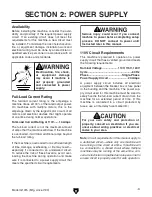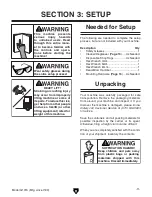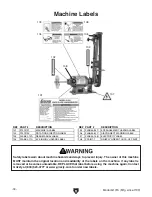
Model G1015 (Mfg. since 7/99)
-23-
Belt Sanding
The sanding belt is used to sand wood or metal.
We recommend using aluminum oxide sanding
belts for wood and silicon carbide for metal. Refer
to
Accessories on Page 24 for options from
Grizzly.
Always be sure the sanding belt is properly
installed, tensioned, and tracked before connect-
ing the machine to power (refer to the
Sanding
Belt subsection on Page 20 for detailed instruc-
tions).
Always adjust the tool rest so that it is no more
than
1
⁄
8
" away from the belt. This helps to ensure
that the workpiece does not get trapped between
the rest and the belt.
Make sure the platen is centered on the sanding
belt. This graphite-faced platen provides an excel-
lent surface for angular sanding or polishing.
Figure 22 shows a typical wood sanding opera-
tion with the tool rest perpendicular to the belt
surface.
Figure 22. Typical wood sanding operation.
The sanding belt is also used for knife grinding
and sharpening.
Figure 23 depicts a typical knife
edge grinding operation. Generally, this is done
with the tool rest removed.
Note: There are many different techniques for
using the sanding belt to grind and sharpen knives.
Whichever one you use, make sure that you hold
the knife firmly and ease it into the belt without
excessive pressure to ensure a safe operation.
Figure 23. Typical knife grinding operation.
The belt is also used for contour sanding. When
doing this type of operation, it is best to remove
the platen and the tool rest so the belt can flex to
better conform to the shape of the workpiece (see
Figure 24).
Figure 24. An example of contour sanding.
Summary of Contents for G1015
Page 15: ...Model G1015 Mfg since 7 99 13 5mm Hardware Recognition Chart...
Page 40: ......
















































